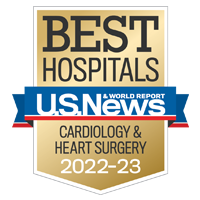
Aortic Coarctation
Aortic coarctation is a narrowing of part of the aorta, the artery that sends oxygenated blood from the heart to the rest of the body. Many people with this condition will not have symptoms until later in life. However, it can lead to hypertension resulting in stroke, congestive heart failure and complications of coronary artery disease.
When the aorta is too narrow, it restricts blood flow to the lower part of the body and increases blood pressure above the narrowing. This means your heart has to work harder to circulate blood to the rest of the body. As a result of the increased work, the heart wall initially thickens, a condition called hypertrophy. If the coarctation is not corrected, heart failure may develop. One of the symptoms of congestive heart failure is breathlessness. If you were born with aortic coarctation, you may have other heart abnormalities such as deformed aortic valves, patent ductus arteriosus or ventricular septal defect.
High blood pressure above the narrowing also can result in high blood pressure in the arteries that branch out from the aorta, including those in the arms and brain. This may increase the risk of a stroke.
Below the narrowing, the blood pressure may be too low and cause problems feeding enough blood into organs such as the kidneys.
Our Approach to Aortic Coarctation
UCSF provides comprehensive, highly specialized care for adults living with heart defects such as aortic coarctation. Our dedicated team of experts offers a wide array of services, including thorough medical evaluations, advanced treatments, long-term monitoring, and personalized recommendations on diet, exercise, psychosocial support and family planning.
These days, we can often repair aortic coarctation using a minimally invasive procedure called cardiac catheterization. During this procedure, the physician inserts a thin, flexible tube, called a catheter, through a small incision in the groin and gently guides it through the blood vessels up to the heart. The physician uses instruments at the end of the catheter to widen the narrowed portion of the aorta and place a stent, an expandable metal tube, in the area to support it. Cardiac catheterization provides complete repair of the narrowed aorta for more than 98 percent of patients.
Awards & recognition
-

Among the top hospitals in the nation
-

One of the nation’s best in cardiology & heart surgery
UCSF Health medical specialists have reviewed this information. It is for educational purposes only and is not intended to replace the advice of your doctor or other health care provider. We encourage you to discuss any questions or concerns you may have with your provider.





